sensor BUICK REGAL 1998 Owners Manual
[x] Cancel search | Manufacturer: BUICK, Model Year: 1998, Model line: REGAL, Model: BUICK REGAL 1998Pages: 388, PDF Size: 20.19 MB
Page 32 of 388
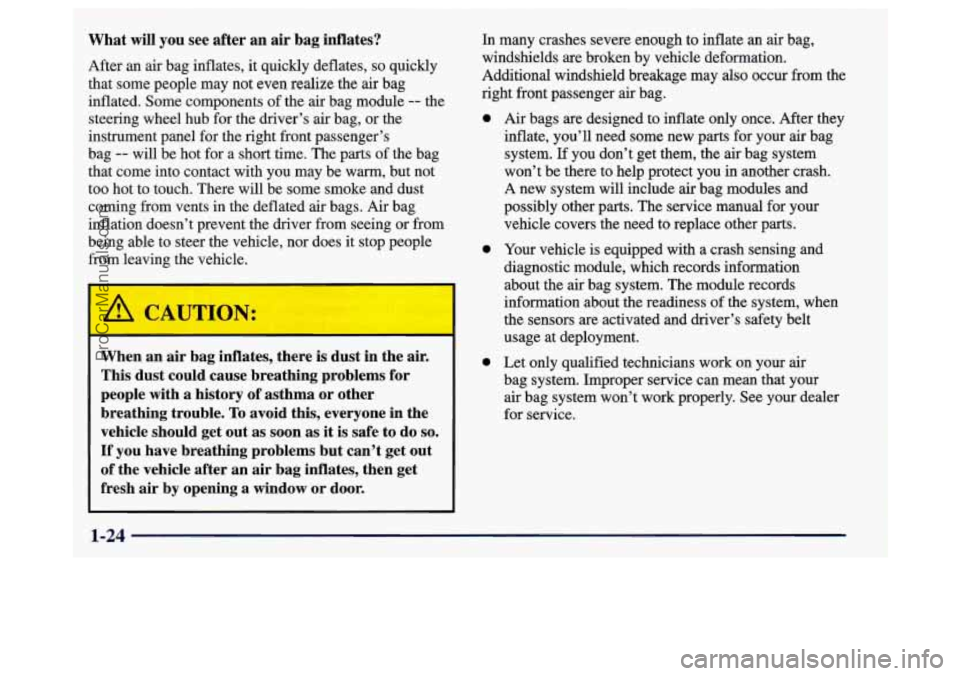
What will you see after an air bag inflates?
After an air bag inflates, it quickly deflates, so quickly
that some people may not even realize the air bag
inflated. Some components of the air bag module
-- the
steering wheel hub for the driver’s air bag, or the
instrument panel for the right front passenger’s
bag
-- will be hot for a short time. The parts of the bag
that come into contact with you may be warm, but not
too hot to touch. There will be some smoke and dust
coming from vents in the deflated air bags. Air bag
inflation doesn’t prevent the driver from seeing or from
being able to steer the vehicle, nor does it stop people
from leaving the vehicle.
/! CAUTION:
When an air bag inflates, there is dust in the air.
This dust could cause breathing problems for
people with a history of asthma or other
breathing trouble. To avoid this, everyone in the
vehicle should get out as soon as it is safe to do
so.
If’ you have breathing problems but can’t get out
of the vehicle after an air bag inflates, then get
fresh air by opening a window or door.
In many crashes severe enough to inflate an air bag,
windshields
are broken by vehicle deformation.
Additional windshield breakage may
also occur from the
right front passenger air bag.
0
0
0
Air bags are designed to inflate only once. After they
inflate, you’ll need some new parts for your air bag
system.
If you don’t get them, the air bag system
won’t be there to help protect you in another crash.
A new system will include air bag modules and
possibly other parts. The service manual for your
vehicle covers the need to replace other parts.
Your vehicle is equipped with a crash sensing and
diagnostic module, which records information
about the air bag system. The module records
information about the readiness of the system, when
the sensors
are activated and driver’s safety belt
usage at deployment.
Let only qualified technicians work on your air
bag system. Improper service can mean that your
air bag system won’t work properly. See your dealer
for service.
1-24
ProCarManuals.com
Page 33 of 388
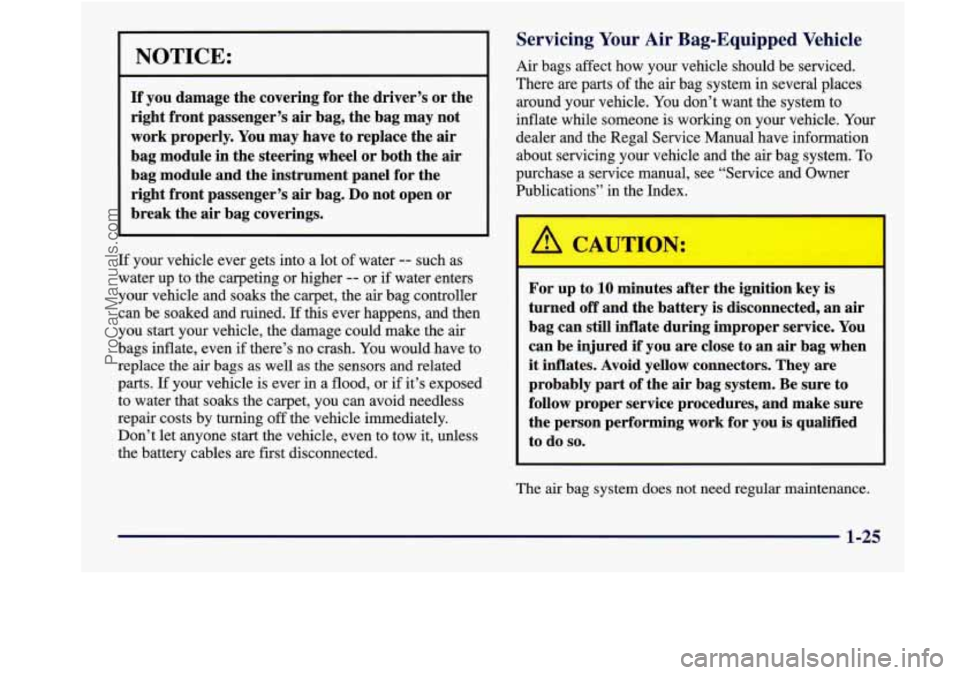
NOTICE:
If you damage the covering for the driver’s or the
right front passenger’s
air bag, the bag may not
work properly. You may have to replace the
air
bag module in the steering wheel or both the air
bag module and the instrument panel for the
right front passenger’s
air bag. Do not open or
break the air bag coverings.
If your vehicle ever gets into a lot of water -- such as
water up to the carpeting or higher
-- or if water enters
your vehicle and soaks the carpet, the air bag controller
can be soaked and ruined.
If this ever happens, and then
you start your vehicle, the damage could make the air
bags inflate, even
if there’s no crash. You would have to
replace the air
bags as well as the sensors and related
parts.
If your vehicle is ever in a flood, or if it’s exposed
to water that
soaks the carpet, you can avoid needless
repair costs by turning off the vehicle immediately.
Don’t let anyone start the vehicle, even to tow it, unless
the battery cables
are first disconnected.
Servicing Your Air Bag-Equipped Vehicle
Air bags affect how your vehicle should be serviced.
There are parts
of the air bag system in several places
around your vehicle.
You don’t want the system to
inflate while someone is working on your vehicle. Your
dealer and the Regal Service Manual have information
about servicing your vehicle and the air bag system. To
purchase a service manual, see “Service and Owner
Publications” in the Index.
For up to 10 minutes after the ignition key is
turned off and the battery is disconnected, an air
bag can still inflate during improper service. You
can be injured
if you are close to an air bag when
it inflates. Avoid yellow connectors. They are
probably part of the air bag system. Be sure
to
follow proper service procedures, and make sure
the person performing work for you
is qualified
to do
so.
The air bag system does not need regular maintenance.
1-25
ProCarManuals.com
Page 98 of 388

NEUTRAL (N): In this position, your engine
doesn’t connect with the wheels.
To restart when you’re
already moving, use
NEUTRAL (N) only. Also, use
NEUTRAL (N) when your vehicle is being towed.
Shifting out of PARK
(P) or NEUTRAL (N) while
your engine is “racing” (running at high speed) is
dangerous. Unless your foot is firmly on the
brake pedal, your vehicle could move very
rapidly. You could lose control and hit people or
objects. Don’t shift out of PARK
(P) or
NEUTRAL (N) while your engine is racing.
-- 1
NOTICE:
Damage to your transaxle caused by shifting out
of PARK (P) or NEUTRAL (N) with the engine
racing isn’t covered by your warranty. AUTOMATIC
OVERDRIVE (0): This position is
for normal driving.
If you need more power for passing,
and
you’re;
Going less than 35 mph (55 kdh), push your
Going about 35 mph (55 kdh) or more, push the
accelerator pedal about halfway down.
accelerator pedal all the way down.
You’ll shift down to the next gear and have
more power.
NOTICE:
If your vehicle seems to start up rather slowly, or
if it seems not to shift gears as you go faster,
something
may be wrong with a transaxle system
sensor.
If you drive very far that way, your
vehicle can be damaged.
So, if this happens, have
your vehicle serviced right away. Until then, you
can use SECOND
(2) when you are driving less
than
35 mph (55 km/h) and AUTOMATIC
OVERDRIVE
(@) for higher speeds.
2-24
ProCarManuals.com
Page 116 of 388
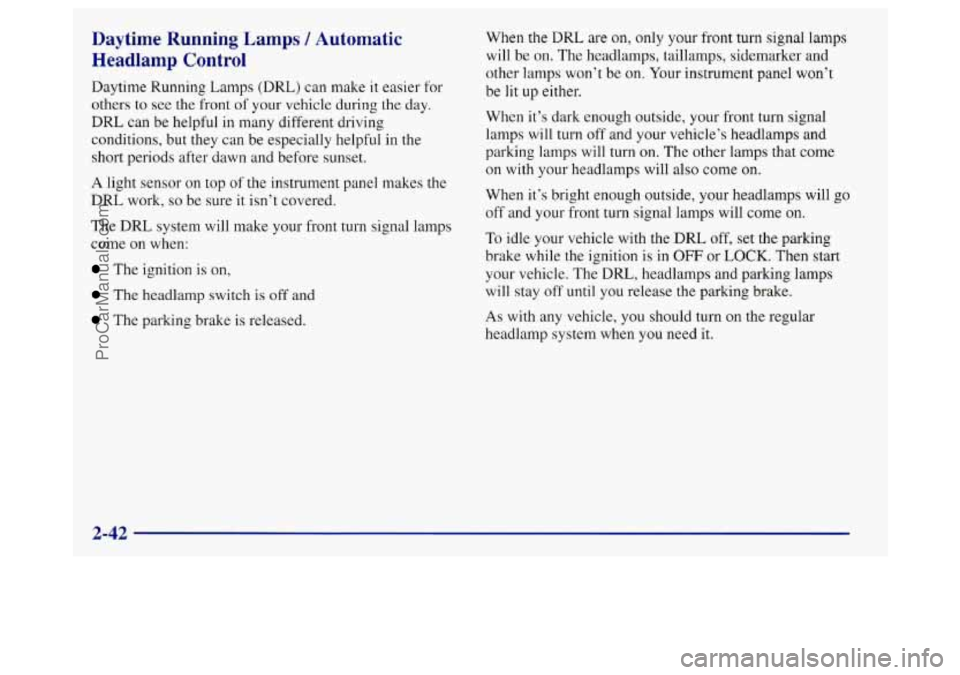
Daytime Running Lamps / Automatic
Headlamp Control
Daytime Running Lamps (DRL) can make it easier for
others to see the front of your vehicle during the day.
DRL can be helpful in many different driving
conditions, but they can be especially helpful in the
short periods after dawn and before sunset.
A light sensor on top of the instrument panel makes the
DRL work,
so be sure it isn’t covered.
The DRL system will make your front turn signal lamps
come on when:
The ignition is on,
The headlamp switch is off and
The parking brake is released. When
the DRL are on, only your front turn signal lamps
will be
on. The headlamps, taillamps, sidemarker and
other lamps
won’t be on. Your instrument panel won’t
be lit up either.
When it’s dark enough outside, your front turn signal
lamps
will turn off and your vehicle’s headlamps and
parking lamps will turn on.
The other lamps that come
on with your headlamps will also come on.
When it’s bright enough outside, your headlamps will
go
off and your front turn signal lamps will come on.
To idle your vehicle with the DRL off, set the parking
brake while the ignition
is in OFF or LOCK. Then start
your vehicle. The
DRL, headlamps and parking lamps
will stay
off until you release the parking brake.
As with any vehicle, you should turn on the regular
headlamp system when you need it.
ProCarManuals.com
Page 146 of 388
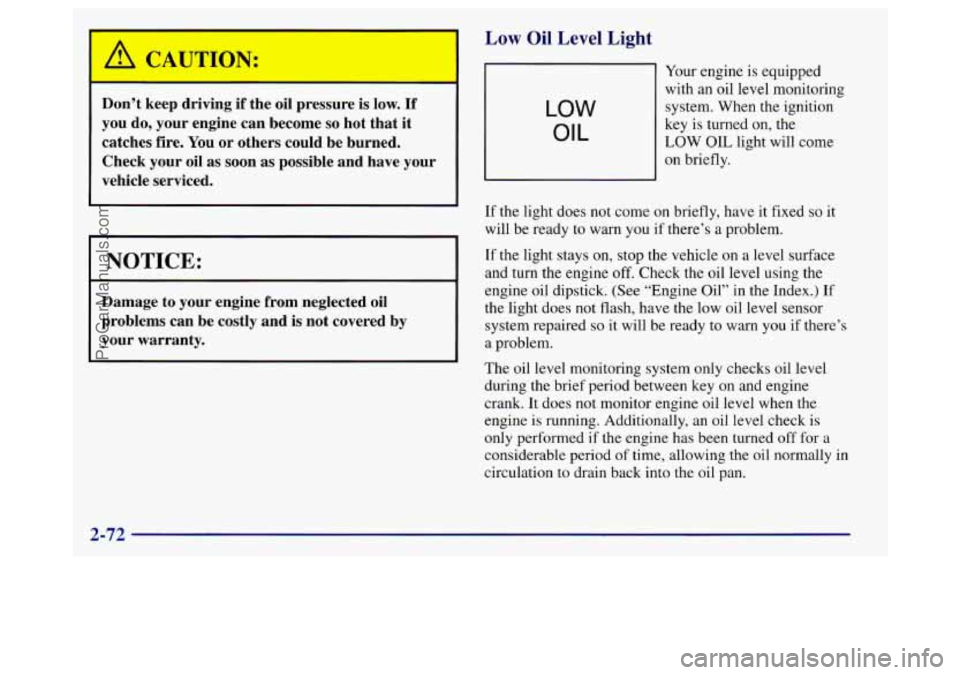
Low Oil Level Light
Don’t keep driving if the oil pressL-d is low. If
you do, your engine can become so hot that it
catches fire. You or others could be burned.
Check your
oil as soon as possible and have your
vehicle serviced.
I NOTICE:
Damage to your engine from neglected oil
problems can be costly and
is not covered by
your warranty.
LOW
OIL
Your engine is equipped
with an oil level monitoring
system. When the ignition
key
is turned on, the
LOW
OIL light will come
on briefly.
If the light does not come on briefly, have it fixed
so it
will be ready to warn you if there’s a problem.
If the light stays on, stop the vehicle on a level surface
and turn the engine
off. Check the oil level using the
engine oil dipstick. (See “Engine Oil” in the Index.) If
the light does not flash, have the
low oil level sensor
system repaired
so it will be ready to warn you if there’s
a problem.
The oil
level monitoring system only checks oil level
during the brief period between key on and engine
crank. It does not monitor engine oil level when the
engine is running. Additionally, an oil level check is
only performed if the engine has been turned off for a
considerable period of time, allowing the oil normally in
circulation
to drain back into the oil pan.
2-72
ProCarManuals.com
Page 238 of 388
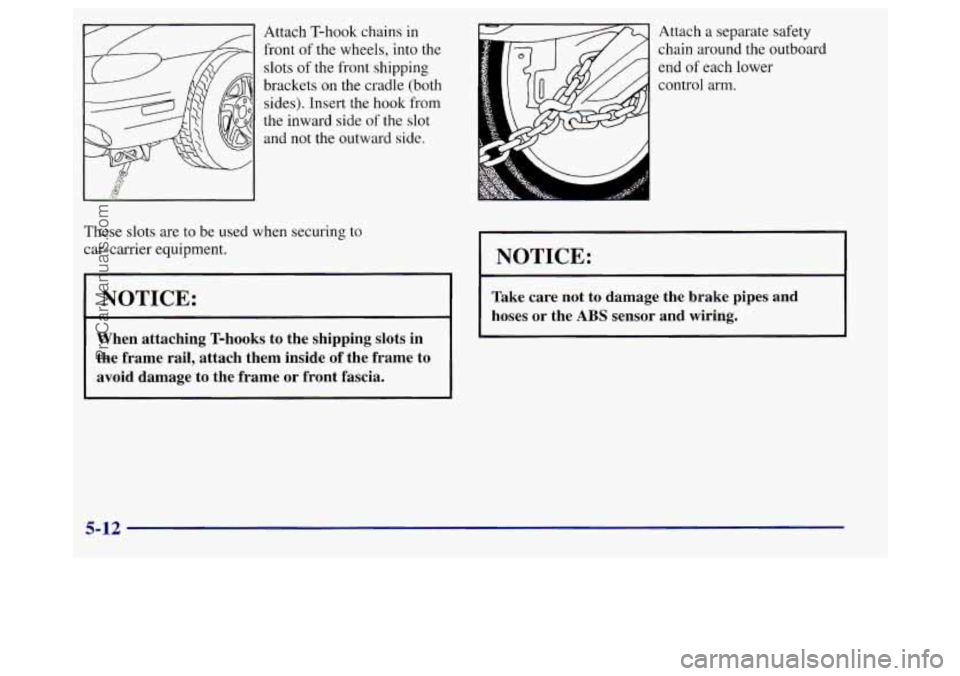
Attach T-hook chains in
front of the wheels, into the
slots
of the front shipping
brackets on the cradle (both
sides). Insert the hook from
the inward side of the slot
and not the outward side.
These slots are
to be used when securing to
car-carrier equipment.
NOTICE:
When attaching T-hooks to the shipping slots in
the frame rail, attach them inside of the frame to
avoid damage to the frame or front fascia.
Attach a separate safety
chain around the outboard
end
of each lower
control arm.
I NOTICE:
I
Take care not to damage the brake pipes and
hoses or the
ABS sensor and wiring. I
5-12
ProCarManuals.com
Page 330 of 388
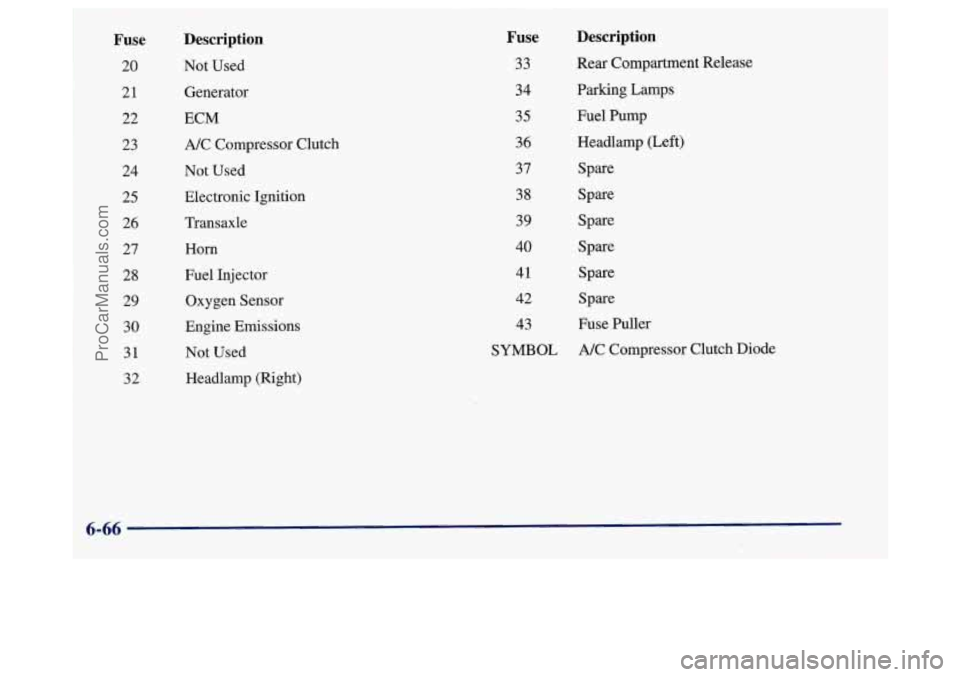
Fuse
20
21
22 23
24 25
26 27
28
29
30
31 32
Description
Not Used
Generator
ECM
A/C Compressor Clutch
Not Used Electronic Ignition
Transaxle
Horn
Fuel Injector
Oxygen Sensor
Engine Emissions
Not Used
Headlamp (Right)
Fuse
33
34 35
36 37
38
39
40
41
42
43
SYMBOL
Description
Rear Compartment Release
Parking Lamps Fuel Pump
Headlamp (Left) Spare Spare
Spare
Spare Spare
Spare
Fuse Puller A/C Compressor Clutch Diode
ProCarManuals.com